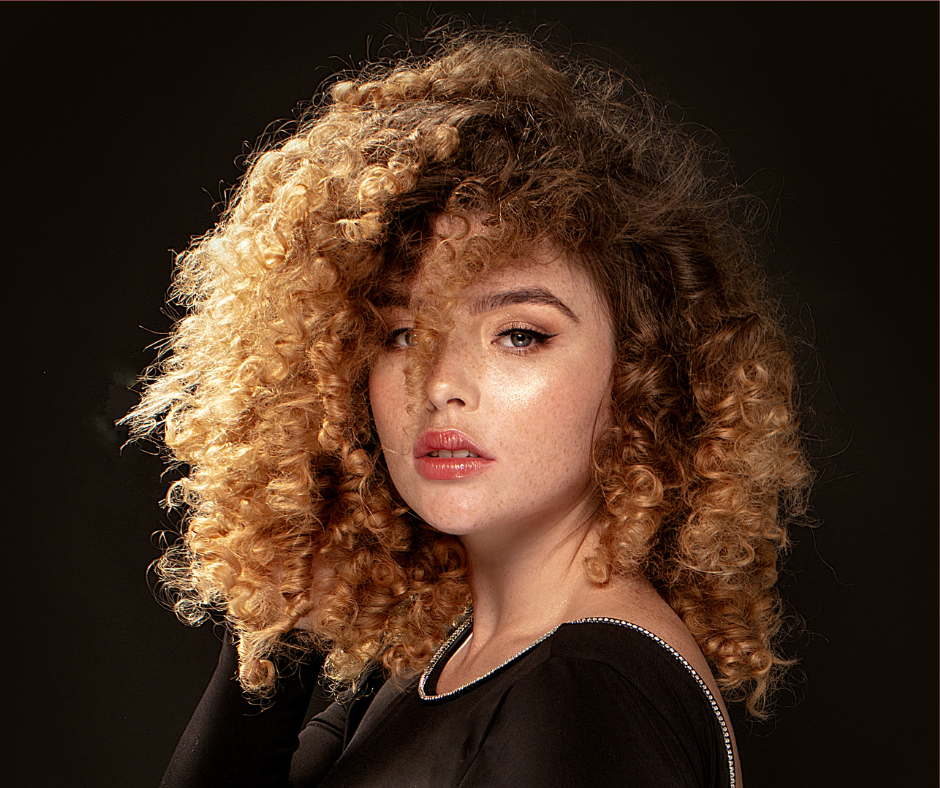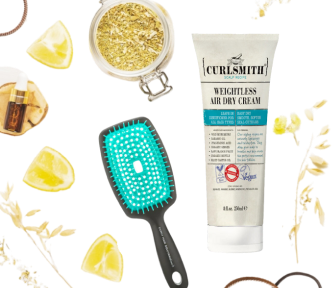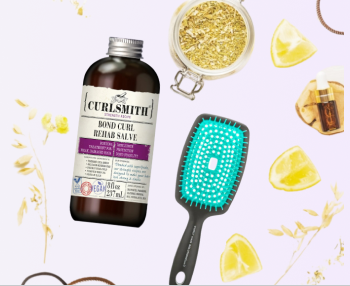If you’re trying to figure out where your curls truly fit, that’s totally normal! Finding your curl type can feel like a bit of a guessing game, but we’re about to make things a whole lot easier for you.
This guide will break down every curly hair type, so you can finally make sense of your curls once and for all!
The Curl Types
Back in the 1990s, celebrity hairstylist Andre Walker created the Hair Chart to help identify different curl types. It’s a system that sorts curls based on their pattern and the way the hair naturally forms.
Andre’s system divides hair into four main categories (1-4), with subcategories (A, B, C) based on how tight or loose the curl is.
Let’s break it all down—starting with the waves! (We’re skipping category 1 because that’s for straight hair.)

Type 2: Wavy Hair
Wavy hair is that sweet spot between straight and curly. It forms soft bends or S-shapes instead of tight curls.
2A
This type is super close to straight hair and can sometimes be mistaken for it. 2A waves are usually fine or thin, with straight roots and a slight wave that adds a bit of body. But they don’t always hold a curl well.
2B
This is where waves start becoming more noticeable and well-defined. 2B hair has more shape and texture than 2A, with a natural beachy look. It also usually comes with more frizz and can hold styles way better.
2C
2C is the waviest of them all, sitting right on the edge of curly territory. These waves are pronounced, well-defined, and tend to get frizzy and poofy without the right styling products. The S-shape is tighter, almost like loose spirals, making this the closest you can get to curls while still being considered wavy.
Since finer textures can get weighed down easily, lightweight products are the way to go. Think mousses like The Doux Mousse Def Texture Foam, leave-ins like Innersense Sweet Spirit Leave-in Conditioner, sea salt sprays like I Create Waves Salt Spray by Innersense, and volumizing shampoos like Volumizing Hair Shampoo by Hair Dance.
Type 3: Curly Hair
Curly hair is all about defined ringlets and spirals. These curls can range from loose, bouncy spirals to tighter, corkscrew-like coils. That’s why curly hair is broken down into three subtypes: 3A, 3B, and 3C, based on how tight the curls are.
3A
3A curls have a looser pattern with lots of natural movement, giving them that signature bounce. Frizz is moderate, and as you move up the curl spectrum, it becomes more of a challenge, but at this stage, it's still pretty manageable.
3B
A step up from 3A, these curls are tighter and more defined, about the thickness of a marker. Frizz becomes more noticeable here - there's no escaping that with curly hair either way!
The good thing is that frizz can be kept under control with the right care and products.
3C
3C curls are the tightest in the curly category, about the size of a pencil or a straw. When it comes to frizz, keeping your curls moisturized and well cared for is a must to minimize it.
Embracing your curly hair is a journey: one that takes patience, love, and the right routine. But beyond that, your styling techniques and products can make all the difference.
Here are some essential products for curly hair:
-
Moisturizers: Hydration is everything for curly hair, regardless of your curl pattern! It's important to choose a leave-in conditioner that suits your hair porosity. If you have low porosity or a finer hair type, Innersense Sweet Spirit Leave-In is a great pick. For high porosity or thicker, coarser hair, Bounce Curl Moisture Balance Leave-in Conditioner is the way to go. And no matter your porosity, you can’t go wrong with TreLuxe Untie the Knot Nourishing Leave-In Conditioner!
-
Curl creams: These help enhance your curl pattern and add definition. A few great ones include Ouidad Curl Quencher Hydrafusion Intense Curl Cream, Boucleme Curl Cream or Bounce Curl Avocado & Rose Oil Clump Define Cream.
-
Gels: If you’re after long-lasting definition and frizz control, a good gel is a must-have. Some solid options for all curl types are Hi! Definition Curl Enhancing Styling Gel by TreLuxe, Innersense I Create Hold Styling Gel and Ouidad Advanced Climate Control Heat & Humidity Gel, which provides a strong hold with a serum-like consistency that won’t weigh your hair down.
-
Diffuser: The Great Big Diffuser is a game-changer for enhancing curl definition and volume while minimizing frizz.
Type 4: Coily Hair
The type 4 group is commonly referred to as afro or kinky hair. Coily hair is much tighter and denser than the curls in the type 3 group. While curly hair forms looser "S" shapes, coily hair has a more compact, springy, zigzag pattern.
As you move up the scale, each type becomes tighter and more compact. And because the coils are so tightly wound—almost like a spring—they experience a lot of shrinkage, making the hair appear much shorter than its actual length when it dries.
4A
4A coils still have a defined curl pattern but are smaller and bouncier, about the size of a straw or a crochet needle. When dry, they can shrink by up to 50%.
4B
4B coils are tighter than 4A but not as densely packed as 4C. They can be hard to distinguish at the root but become more visible at the ends. Instead of forming defined curls, the strands take on a zigzag shape. Shrinkage can reach up to about 70%.
4C
4C hair has very tight coils. These strands shrink by 80% or more, making it one of the most compact hair types. Achieving a defined look takes a bit more effort, but the right products can definitely help!
Since coily hair is so tightly coiled, natural oils and sebum have a harder time travelling down the strands. This makes it more prone to dryness and breakage, so gentle handling, protective styles, and lots of hydration are key.
Some great product options for type 4 hair include:
-
Moptop Curl Enhancer Gel: This lightweight, strong-hold gel will leave a crunchy cast that breaks away to leave your hair feeling like there's nothing on it at all.
-
Camille Rose Curl Maker: The oil base of this product makes it rich and velvety, adding shine and hold in one.
-
Aunt Jackie’s Curl La La Curl Defining Custard: Custards often contain moisturizers as well as hold ingredients so they are excellent choices for type 4 hair. Their thick consistency thins out when applied with a lot of water.
- Mielle Organics Pomegranate & Honey Coil Sculpting Custard: This product was specifically formulated for type 4 hair. It provides exceptional definition and moisture for kinks and coils.
- The Doux Bee Girl Crazy Sexy Curl Setting Foam: Great for protective styles, wash 'n' gos, twist outs, and more, this foam does it all. It detangles, conditions, defines, and most importantly, sets your style, regardless of how you're wearing your hair.
- Uncle Funky's Curly Magic Curl Stimulator: The marshmallow root in this best-selling product makes it slippery and easy to distribute on all hair types and patterns.

How Important is Curl Type When it Comes to Choosing Products?
While knowing your curl type can be fun, it’s not the most important thing when it comes to hair care. In fact, we don’t recommend choosing products based on curl type alone.
What matters most when it comes to how well a product will work on your hair are factors like hair porosity, thickness or density, hair goals, and the level of damage.
Why? Because hair type isn’t set in stone. It can change over time due to things like aging, hormones, medication, or how healthy it is. Plus, most people don’t have just one curl type; your hair can be a mix, and it might even look different depending on the products you use or how you style it.
If there’s one thing that truly impacts your routine, it’s porosity (how quickly your hair absorbs, holds on to, and releases water). You can find our most popular products based on your porosity here:
And that’s a wrap on curl types!
Still need help figuring out the right products for your curls? Send us an email at products@curlwarehouse.com or visit us in-store!








